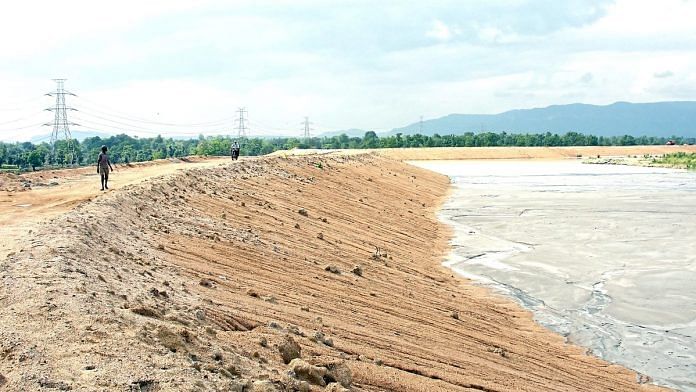New Delhi: Thermal power plants and lignite plants that do not utilise 100 per cent of the fly ash they generate in an “eco-friendly” way will now face penalties, under a new set of rules notified by the Narendra Modi government.
Fly ash is the residue of coal combustion, which, if disposed of improperly, is hazardous for health and the environment due to the concentrated presence of heavy metals.
The notification from the Union Ministry of Environment, Forest and Climate Change intends to “bring out a comprehensive framework for ash utilisation including a system of environmental compensation based on polluter-pays principle”. This is a first in the country.
Thermal power plants must utilise 100 per cent of their yearly fly ash output within a three-year cycle to avoid penalties, the 31 December notification says, adding that “at no point” should utilisation fall below 80 per cent.
The plants that fail to have 100 per cent utilisation levels within this period will be forced to pay the Central Pollution Control Board (CPCB) Rs 1,000 per tonne of unutilised ash.
The notification acknowledges “legacy ash”, or the build-up of fly ash by thermal power plants over decades, saying that this must be utilised over a period of 10 years from the time the notification is applicable, from 1 April 2022 onwards. Legacy ash must be dealt with “over and above” the yearly ash output by power plants, the notification says.
India has over 200 coal power plants that generate an enormous amount of fly ash. According to the Central Electricity Authority, India’s coal plants generated 232.56 million tonnes of fly ash in 2020-2021. Although 93 per cent of it was utilised, millions of tonnes accumulated over the years lie unused.
A study by think tank Centre for Science and Environment in March 2021 found that over half of India’s power plants failed to fully utilise their fly ash and fell behind previous government targets.
The new notification will replace the 1999 notification that had originally set up rules for fly ash utilisation. It will also supersede the various amendments to the 1999 notification made in 2003, 2009 and 2016, which have all sought to manage the generation of fly ash.
Also read: The world has a new path to sustainable energy and net zero emissions — ‘green hydrogen’
‘Eco-friendly’ utilisation
The latest notification is largely similar to the draft that had been released for public comments in April 2021.
Dumping fly ash on land needs to be prevented, and it should be dealt with in an “eco-friendly” manner, the new notification says.
It lists “the only” ways in which the fly ash can be utilised, which include the manufacturing of bricks, tiles, cement, construction of roads, and export to other countries. It also allows for the “filling of low-lying areas”, filling of empty mines, and “agriculture in a controlled manner based on soil testing”.
The notification adds that the compensation money collected by the CPCB for ash that hasn’t been utilised will be used “towards the safe disposal of the unutilised ash” as well as research on ash-based products.
Also read: Solid waste could play an important role in fueling airlines
What experts say
According to experts, the introduction of a penalty for non-compliance and acknowledgement of legacy ash is a step in the right direction, but there are other facets that the notification doesn’t adequately address.
“The notification calls the filling of low-lying areas an eco-friendly method of utilising fly ash, but more often than not, this is a euphemism for irresponsibly dumping ash. Dumping ash in low-lying areas can lead to severe ecological consequences,” said Sehr Raheja, a researcher with Manthan Adhyayan Kendra, a civil society organisation that wrote to the government in April last year, when comments on the draft notification had been invited.
A report co-authored by Manthan found that there were eight major fly ash breaches between 2019 and 2021, leading to destruction and contamination.
While the notification says that all yearly and legacy ash must be utilised, it also makes a provision for ash stored in dykes and ponds — structures built for large amounts of ash disposal — saying that as long as such storage is “stabilised” or reclaimed by growing plantations, coal power plants certified with the CPCB can be excluded from the 10-year deadline.
“We also worry that this will create a loophole for coal power plants not to utilise their legacy ash,” Raheja added.
Think tank Centre for Policy Research (CPR) had also submitted comments in April last year, saying a 10-year deadline to comply with 100 per cent utilisation of legacy ash “eases the legal burden of compliance but allows for illegal dumps of overloaded ash dykes to continue” despite risks of accidents and contamination.
The CPR also said the draft notification didn’t address the issue of fly ash generation, which is the underlying cause for build-up and environmental damage. It also urged the government to recognise that fly ash is a public health hazard.
“It is critical to take policy measures to link fly ash utilisation with steps being taken by the government to prevent diseases and deaths and provide health services. The environmental regulation that emerges from this approach of ‘fly ash as a health risk’ has the potential to identify remedies to address legacy impact and prevent future legal breaches,” CPR wrote in its comments.
However, the final notification does not incorporate this point.
(Edited by Amit Upadhyaya)
Also read: From 1,260 to 150 — why power transmission lines are ‘biggest threat’ to Great Indian Bustard



